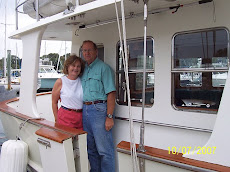The final day, and the last 22 miles in North Carolina/Virginia, was the Dismal Swamp Canal, the oldest continually operating hand-dug waterway in the country. One of the first investors was George Washington. Digging by hired slave labor, digging began in 1793 and first opened in 1805. Today it is open for boaters interested in seeing the magnificent countryside of the cypress swamp. Locks at both ends lift you the 8 feet to the level of the swamp.


Unfortunately, a 65 ft sportfish traveled the canal the day before us at high speed leaving a huge wake. The bottom debris was so disturbed that every boat since complained of bumping logs and bent props. The sound of submerged logs hitting the hull was like a tennis shoe in a clothes dryer. With much relief and no damage we tied up in Portsmouth and had martinis on Duet.
Departing Portsmouth/Norfolk we passed the BigE, the first nuclear powered aircraft carrier, and the George HW Bush, one the the newest aircraft carriers.




























































